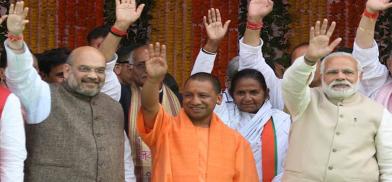Uttar Pradesh will be a bellwether of Modi's continuing popularity
A defeat in Punjab or in Goa will not bother the BJP too much. But UP is different not only because its location in the heartland has always provided significant pointers about political trends, writes Amulya Ganguli for South Asia Monitor

More than any of the five states which are going to the polls next year along with Uttar Pradesh, India's ruling Bharatiya Janata Party’s (BJP) focus is almost entirely on the Hindi heartland province where it has to win in order to erase some of the humiliation it suffered by losing heavily in West Bengal.
Hence, the meetings chaired by the prime minister on UP and the frequent visits to the state by the BJP and Rashtriya Swayamsevak Sangh (RSS) - the BJP's ideological font - top brass, obviously for shoring up Yogi Adityanath's government. The need for a show of support for the chief minister may have been felt by the party for two reasons. One is the prevailing belief that he badly mishandled the Covid situation, and the other is the comment by one of his ministers that the chief minister will be chosen after the polls.
The doubts which the minister expressed have since been removed with others reaffirming that the saffron-robed monk-politician will be the face of the party in the next election. But there is little doubt that the BJP poster boy’s image has been dented by the heart-rending scenes of bodies floating in the Ganga, the rows of funeral pyres and of a hospital where patients were being looked after by the ward boys.
Weak, divided opposition
The concern in the BJP and the RSS, therefore, about how the party will fare in India's most populous state, which sends the largest chunk of 80 MPs to Parliament, is understandable. Its only hope is that as in the rest of the country, the opposition in UP is not strong enough to put up a tough fight.
With the Congress not visible on the ground and the regional Bahujan Samaj Party’s (BSP) reliability in doubt, the main challenger appears to be the other regional party, Samajwadi Party (SP). But after a satisfactory showing in the recent panchayat elections where it pipped the BJP at the post, the SP failed to put up a fight in some of the subsequent contests at the district level, thereby giving the BJP a walkover.
Considering that the SP's ailing supremo Mulayam Singh Yadav had expressed the hope in parliament that Narendra Modi will remain the prime minister, and the internal squabbles in the Yadav family between Mulayam Singh’s son, Akhilesh, who is the SP president, and his estranged uncle Shivpal, the SP doesn’t seem to have the same zest for fighting the BJP as the other party of the Yadavs in the 'cow belt', the Rashtriya Janata Dal (RJD) of neighbouring Bihar.
As is known, the RJD fought a gritty battle against the Janata Dal (United)-BJP combine last year, emerging as the first party in the 243-member state assembly with 75 seats although it lost the election.
Whether Akhilesh Yadav will be able to emulate the RJD chief, Tejashvi Yadav’s feat is not known although with an ally like the Jat-based Rashtriya Lok Dal (RLD) on his side and with the protesting farmers (who are also mostly Jats) firm in their opposition to the BJP, the SP can be expected to run the BJP close.
Administrative failures
As for the BJP, it will probably continue to bank on the formula of enticing the non-Yadav OBCs (other backward castes) and the non-Jatav Dalits to its side to weaken the Yadav-based SP and the Jatav-based BSP.
The BJP also undoubtedly expects the promise of building a Rs 50 crore memorial for B R Ambedkar - the Dalit icon considered the architect of India's Constitution - to bring a sizeable number of Dalits – both Jatavs and non-Jatavs – to its side to widen its support base which has the upper castes at its core.
This calculation worked for the BJP in the last assembly election. But Modi was riding high then on his "achhey din" (good days are coming) popularity. Today’s scene, however, is different not only with the dimming of the promise of good days, but also because the pandemic has exposed the government’s feet of clay where the administration is concerned.
Can Adityanath deliver?
Yogi Adityanath’s personal idiosyncrasies are also crucial in this context - his supposed partiality towards the members of his own clan, the Thakurs, his dependence on officials at the expense of the party lawmakers, his polarizing rhetoric which divides the populace into "Bajrang Balis (Hindus) and Alis (Muslims)", the hounding of interfaith couples under the “love jehad” laws, the use of the police to resort to "fake encounters".
Yet, the BJP has to overcome these hurdles because a setback in UP will be no less than a crushing blow in the wake of the Bengal debacle, for it will send a deeply worrying message about the party’s prospects in the next general election for Prime Minister Modi.
A defeat in Punjab or in Goa will not bother the BJP too much. But UP is different not only because its location in the heartland has always provided significant pointers about political trends, but also because the BJP and the RSS used the state in the last four-and-a-half years to test the viability of their Hindutva projects through its hawkish chief minister in India's most politically consequential state.
A failure will mean that the two organizations will have to go back to the drawing board to figure out how and where to start all over again. Such an endeavor that will denote a setback for Modi and the BJP cannot but be dispiriting when the next general election in 2024 is not all that far away.
(The writer is a commentator on current affairs. The views expressed are personal)









Post a Comment